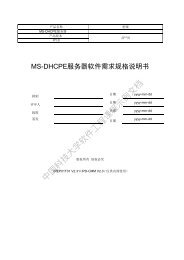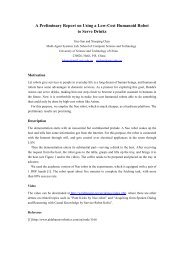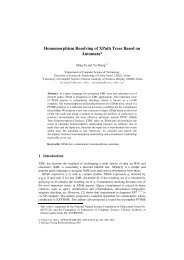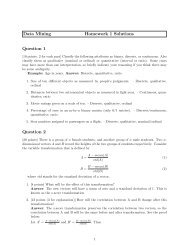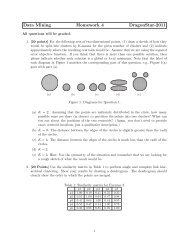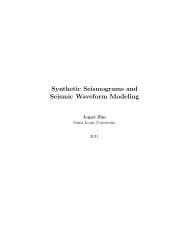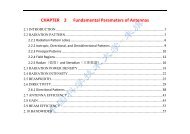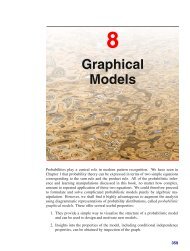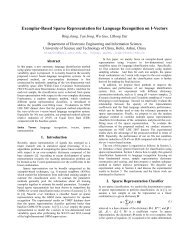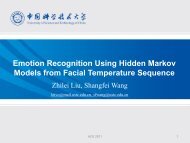Donoho and Huo
Donoho and Huo
Donoho and Huo
Create successful ePaper yourself
Turn your PDF publications into a flip-book with our unique Google optimized e-Paper software.
IEEE TRANSACTIONS ON INFORMATION THEORY, VOL. 47, NO. 7, NOVEMBER 2001 2845<br />
Uncertainty Principles <strong>and</strong> Ideal Atomic<br />
Decomposition<br />
Abstract—Suppose a discrete-time signal @ A, H ,<br />
is a superposition of atoms taken from a combined time–frequency<br />
dictionary made of spike sequences I a <strong>and</strong> sinusoids<br />
P A . Can one recover, from knowledge of<br />
alone, the precise collection of atoms going to make up ? Because<br />
every discrete-time signal can be represented as a superposition<br />
of spikes alone, or as a superposition of sinusoids alone, there is<br />
no unique way of writing as a sum of spikes <strong>and</strong> sinusoids in<br />
general.<br />
We prove that if is representable as a highly sparse superposition<br />
of atoms from this time–frequency dictionary, then there is<br />
only one such highly sparse representation of , <strong>and</strong> it can be obtained<br />
by solving the convex optimization problem of minimizing<br />
the I norm of the coefficients among all decompositions. Here<br />
“highly sparse” means that C P where is the<br />
number of time atoms, is the number of frequency atoms, <strong>and</strong><br />
is the length of the discrete-time signal.<br />
Underlying this result is a general I uncertainty principle which<br />
says that if two bases are mutually incoherent, no nonzero signal<br />
can have a sparse representation in both bases simultaneously. For<br />
the above setting, the bases are sinuosids <strong>and</strong> spikes, <strong>and</strong> mutual<br />
incoherence is measured in terms of the largest inner product between<br />
different basis elements. The uncertainty principle holds for<br />
a variety of interesting basis pairs, not just sinusoids <strong>and</strong> spikes.<br />
The results have idealized applications to b<strong>and</strong>-limited approximation<br />
with gross errors, to error-correcting encryption, <strong>and</strong> to<br />
separation of uncoordinated sources.<br />
Related phenomena hold for functions of a real variable, with<br />
basis pairs such as sinusoids <strong>and</strong> wavelets, <strong>and</strong> for functions of two<br />
variables, with basis pairs such as wavelets <strong>and</strong> ridgelets. In these<br />
settings, if a function is representable by a sufficiently sparse<br />
superposition of terms taken from both bases, then there is only<br />
one such sparse representation; it may be obtained by minimum<br />
I norm atomic decomposition. The condition “sufficiently sparse”<br />
becomes a multiscale condition; for example, that the number of<br />
wavelets at level plus the number of sinusoids in the th dyadic<br />
frequency b<strong>and</strong> are together less than a constant times P P .<br />
Index Terms—Basis pursuit, combinatorial optimization, convex<br />
optimization, error-correcting encryption, harmonic analysis,<br />
Logan’s phenomenon, matching pursuit, multiple-basis signal<br />
representation, overcomplete representation, ridgelet analysis,<br />
uncertainty principle, wavelet analysis.<br />
Manuscript received June 1, 1999; revised July 19, 2001. This work was supported<br />
by National Science Foundation under Grant DMS 95-05151, <strong>and</strong> by<br />
NSF under Grant ECS-97-07111.<br />
D. L. <strong>Donoho</strong> is with the Statistics Department, Stanford University, Stanford,<br />
CA 94305 USA (e-mail: donoho@stanford.edu).<br />
X. <strong>Huo</strong> is with the School of Industrial <strong>and</strong> Systems Engineering, Georgia<br />
Institute of Technology, Atlanta, GA 30332 USA (e-mail: xiaoming@isye.<br />
gatech.edu).<br />
Communicated by J. A. O’Sullivan, Associate Editor for Detection <strong>and</strong> Estimation.<br />
Publisher Item Identifier S 0018-9448(01)08946-5.<br />
David L. <strong>Donoho</strong>, Member, IEEE, <strong>and</strong> Xiaoming <strong>Huo</strong><br />
0018–9448/01$10.00 © 2001 IEEE<br />
I. INTRODUCTION<br />
RECENTLY, workers in the computational harmonic analysis<br />
community have developed a number of interesting<br />
new signal representations; see [9], [23], [30]. In addition to sinusoids<br />
<strong>and</strong> wavelets, we now have Wilson bases, [10], wavelet<br />
packets, <strong>and</strong> cosine packets [8]. Moreover, the list of such representations<br />
is exp<strong>and</strong>ing all the time; recent additions include<br />
ridgelets <strong>and</strong> curvelets [5], [4].<br />
In each of these cases, we have an orthonormal basis or tight<br />
frame which has been designed to be effective at representing<br />
objects of a specific type, where “effective” means requiring<br />
very few significant coefficients. The transforms turn out to be<br />
complementary in the sense that the type of objects for which<br />
one transform is well-suited are unlike the objects for which another<br />
transform is well-suited. For example, wavelets perform<br />
relatively poorly on high-frequency sinusoids, for which sinusoids<br />
are (naturally) very effective. On the other h<strong>and</strong>, sinusoids<br />
perform poorly on impulsive events, for which wavelets are very<br />
effective. In dimension , wavelets do poorly with discontinuities<br />
on edges, for which ridgelets are effective, while ridgelets<br />
do poorly on impulsive events [5].<br />
It is natural in such a setting to imagine combining signal representations,<br />
using terms from each of several different bases.<br />
One supposes that the object of interest is a superposition of<br />
two phenomena, one of which by itself can be effectively represented<br />
in basis <strong>and</strong> the other of which by itself can be effectively<br />
represented in basis , <strong>and</strong> one hopes that by allowing a<br />
representation built from terms in both bases, one might obtain<br />
an effective representation—far more effective than what one<br />
could obtain using either basis alone. Specifically, one hopes to<br />
represent an object containing two phenomena in superposition<br />
with the efficiency one would expect in analyzing each phenomenon<br />
separately in its own appropriate basis.<br />
Such speculation leads one to propose the use of dictionaries<br />
made from a concatenation of several<br />
orthonormal bases , <strong>and</strong> to seek representations of<br />
a signal as<br />
(1.1)<br />
where is an index into the dictionary, naming both<br />
the basis <strong>and</strong> the specific basis element. The general aim is to<br />
find concrete methods which offer decompositions of better<br />
sparsity through the use of several representations than is<br />
possible through any one representation alone. In the field of<br />
computational harmonic analysis, Mallat <strong>and</strong> Zhang [24] were<br />
early advocates of this approach, <strong>and</strong> introduced the “dictionary<br />
Authorized licensed use limited to: University of Science <strong>and</strong> Technology of China. Downloaded on February 18, 2009 at 03:58 from IEEE Xplore. Restrictions apply.
2846 IEEE TRANSACTIONS ON INFORMATION THEORY, VOL. 47, NO. 7, NOVEMBER 2001<br />
methodology.” Coifman <strong>and</strong> collaborators have made numerous<br />
related contributions in this field also. In the field of signal<br />
processing, a considerable body of related practical work has<br />
been done in the general area of multiple-basis signal representation<br />
<strong>and</strong> signal compression. See, for example, the survey<br />
paper of Berg <strong>and</strong> Mikhael [3], who mention seminal work of a<br />
decade ago by Mikhael <strong>and</strong> Spanias [26] <strong>and</strong> Beex [2]. There<br />
is ongoing more recent work by DeBrunner <strong>and</strong> collaborators<br />
in signal representation [12] <strong>and</strong> in image representation [11].<br />
Finally, we mention the thesis of <strong>Huo</strong> [19].<br />
Mallat <strong>and</strong> Zhang [24] proposed a heuristic greedy approximation<br />
method for representation using overcomplete dictionaries,<br />
called Matching Pursuit. While Matching Pursuit works<br />
well in many cases, it is known not to provide sparse approximations<br />
in general; see the counterexamples in [7], [13].<br />
As is the concatenation of several bases, the representation<br />
(1.1) is not unique; any single basis alone affords already<br />
decomposition of an arbitrary signal , <strong>and</strong> consequently many<br />
possibilities for combined decomposition arise. The general<br />
goal would be to find a highly sparse decomposition—one with<br />
very few nonzero terms. This leads to the optimization problem<br />
where : is the quasi-norm. Unfortunately,<br />
in general, this problem requires a search through subsets<br />
of looking for a sparse subset providing exact decomposition.<br />
Chen, <strong>Donoho</strong>, <strong>and</strong> Saunders [6], [7] proposed an alternate<br />
approach to signal decomposition in dictionaries, which they<br />
called Basis Pursuit (BP). It calls for solving the optimization<br />
problem<br />
where is the norm of the coefficients. This<br />
is a convex optimization problem, <strong>and</strong> can be attacked using<br />
linear programming methods based either on the classical simplex<br />
method of linear programming or the recently popular interior<br />
point methods [32]. As the norm is, in a certain natural<br />
sense, a convexification of the norm, the problem can<br />
be viewed as a convexification of , one which makes accessible<br />
a variety of computationally feasible strategies.<br />
In [7], it was shown that, empirically, the solution of BP is<br />
frequently quite sparse; <strong>and</strong> that in fact when the underlying<br />
synthesis was made from only a few dictionary elements, the<br />
BP solution may perfectly recover the specific atoms <strong>and</strong> specific<br />
coefficients used in the synthesis. For example, Chen considered<br />
a sum of four sinusoids <strong>and</strong> two spikes, decomposed<br />
them in a combined time–frequency dictionary of sinusoids <strong>and</strong><br />
spikes, <strong>and</strong> found that BP recovered exactly the indexes <strong>and</strong> coefficients<br />
of the terms involved in the synthesis; this held across<br />
a wide range of amplitude ratios between the sinusoid <strong>and</strong> spike<br />
components. In contrast, the same signal was analyzed using<br />
Matching Pursuit, the recovery of indexes <strong>and</strong> coefficients was<br />
only approximate <strong>and</strong> became very inexact when the sinusoidal<br />
<strong>and</strong> spike components were at very different amplitudes.<br />
s.t.<br />
s.t.<br />
A. Ideal Atomic Decomposition<br />
Our goal in this paper is to prove that in certain specific cases,<br />
when the signal is a sufficiently sparse sum of terms from a dictionary,<br />
the BP principle of optimization of the decomposition<br />
from that dictionary in fact gives the solution of the<br />
optimization problem <strong>and</strong> in fact recovers the identities <strong>and</strong> coefficients<br />
of the original synthesizing elements perfectly.<br />
The following terminology helps formalize this phenomenon.<br />
If is an overcomplete system, any representation<br />
is an atomic decomposition using atoms from the<br />
dictionary.If in fact can be generated by a highly sparse sum,<br />
with the term “highly sparse” given an appropriate definition,<br />
<strong>and</strong> there is in fact only one such highly sparse way of doing so,<br />
<strong>and</strong> if an optimization principle finds that decomposition, we<br />
say that the principle leads to ideal atomic decomposition under<br />
the stated sparsity hypothesis. In effect then, we are claiming<br />
that under certain sparsity conditions, the minimum -norm<br />
decomposition in certain dictionaries achieves an ideal atomic<br />
decomposition.<br />
B. Time–Frequency Decomposition<br />
We initially consider the situation where with<br />
the spike basis<br />
<strong>and</strong> the Fourier basis<br />
Both <strong>and</strong> are orthonormal bases for .<br />
Theorem I.1: Let<br />
where is a subset of the “time domain” <strong>and</strong> is a<br />
subset of the “frequency domain” .If<br />
then has a unique solution. Meanwhile, there exist<br />
so that<br />
<strong>and</strong> has a nonunique solution.<br />
Theorem I.2: Let<br />
with as in Theorem I.1. If<br />
then has a unique solution, which is also the unique solution<br />
of . Meanwhile, there exist so that<br />
<strong>and</strong> has a nonunique solution.<br />
In short, if the signal truly has a very sparse decomposition<br />
in the time–frequency dictionary, this is unique, <strong>and</strong> basis pursuit<br />
( decomposition) will find it.<br />
C. Relation to the Uncertainty Principle<br />
Underlying Theorems I.1 <strong>and</strong> I.2 is an uncertainty principle:<br />
the analysis of a signal in the time <strong>and</strong> frequency domains<br />
Authorized licensed use limited to: University of Science <strong>and</strong> Technology of China. Downloaded on February 18, 2009 at 03:58 from IEEE Xplore. Restrictions apply.
DONOHO AND HUO: UNCERTAINTY PRINCIPLES AND IDEAL ATOMIC DECOMPOSITION 2847<br />
cannot yield a transform pair which is sparse in both domains<br />
simultaneously.<br />
To explain this connection, note that in order to take ideal<br />
atomic decomposition seriously we must know that under<br />
sufficiently strict interpretation of the term “sparsity,” a signal<br />
cannot be sparsely synthesized from both the frequency side<br />
alone <strong>and</strong> from the time side alone. If this were possible, the<br />
atomic decomposition would be nonunique.<br />
Now suppose there existed a signal whose Fourier transform<br />
was very sparse <strong>and</strong> whose representation in the st<strong>and</strong>ard basis<br />
was very sparse. Then we would have exactly an example of<br />
such nonunique sparse decomposition: the signal could be represented<br />
in two different ways: as a sparse sum of sinusoids <strong>and</strong><br />
as a sparse sum of spikes.<br />
In effect, at the center of our analysis of the decomposition<br />
in this finite- , discrete-time setting is exactly a certain<br />
picket fence sequence which may equally be viewed either<br />
as a relatively sparse sum of sinusoids or an equally sparse sum<br />
of spikes. This sequence has been studied before in connection<br />
with the uncertainty principle, for which it serves as a kind of<br />
extremal function [15]; see also recent work of Przebinda, De-<br />
Brunner, <strong>and</strong> Özaydin [27].<br />
The connection between unique decomposition <strong>and</strong> the uncertainty<br />
principle will emerge repeatedly, <strong>and</strong> in a quantitative<br />
form, throughout the paper. It is closely connected to work on<br />
the uncertainty principle in [15], [16], however, the uncertainty<br />
principle employed here gives a more symmetric role for time<br />
<strong>and</strong> frequency.<br />
D. Nonlinearity of the Norm<br />
The phenomenon of ideal atomic decomposition is very special;<br />
it follows from very particular properties of the norm. In<br />
effect, asks to find the member of a linear subspace closest<br />
to the origin in norm. This closest point problem (which<br />
would be a linear problem in norm) is highly nonlinear in<br />
norm, <strong>and</strong> the nonlinearity is responsible for our phenomenon.<br />
A precedent for this type of perfect recovery is what has been<br />
called Logan’s Phenomenon in [15]; see also [22], [16]. That<br />
phenomenon occurs when one is trying to find a decomposition<br />
of a signal into b<strong>and</strong>-limited function <strong>and</strong> impulsive noise;<br />
supposing that the product of the signal b<strong>and</strong>width <strong>and</strong> the measure<br />
of the support of the noise is sufficiently small, this can be<br />
done perfectly, by finding the b<strong>and</strong>-limited function closest to<br />
the observed signal in an sense. The phenomenon is highly<br />
nonlinear in the sense that perfect reconstruction holds at all<br />
signal/noise ratios. See Section V below.<br />
In a sense, the phenomenon exposed in this paper is due to<br />
the same nonlinearity of the norm, only transposed into the<br />
setting of approximation from arbitrary time–frequency dictionaries<br />
in which time <strong>and</strong> frequency play a symmetric role, <strong>and</strong><br />
in which there is no need for the frequency support of the signal<br />
to be an interval or even to be known.<br />
E. Other Dictionary Pairs<br />
In fact, the methods of this paper provide insights outside of<br />
the setting of time–frequency pairs. We give two examples. The<br />
first considers dictionaries of sinusoids <strong>and</strong> wavelets.<br />
Theorem I.3: Let denote a square-integrable function<br />
on the circle . Suppose that is a superposition of sinusoids<br />
<strong>and</strong> wavelets<br />
(1.2)<br />
Here, the are the Meyer–Lemarié wavelets, <strong>and</strong> .<br />
There is a constant with the following property. Let<br />
be the number of Meyer wavelets at resolution<br />
level <strong>and</strong> let be the number of sinusoids<br />
at frequencies . Suppose that the sum obeys all<br />
the conditions<br />
(1.3)<br />
Consider the overcomplete dictionary consisting of<br />
Meyer–Lemarié wavelets <strong>and</strong> of high-frequency sinusoids ,<br />
. There is at most one way of decomposing a<br />
function in the form (1.2) while obeying (1.3). If has such<br />
a decomposition, it is the unique solution to the minimum<br />
optimization problem<br />
In short, minimum decomposition, which makes no assumption<br />
about the sparsity or nonsparsity of the representation<br />
of , nevertheless gives ideal atomic decomposition when sufficient<br />
sparsity is present.<br />
Note however, that the notion of sparsity becomes level-dependent.<br />
We can tolerate more total terms at high resolution than<br />
we can at low resolution. Intuitively, this is because there is less<br />
possibility of confusion between sparse sums of wavelets <strong>and</strong><br />
sparse sums of sinusoids as we go to sums limited to dyadic<br />
b<strong>and</strong>s at increasingly high frequencies—the two systems become<br />
increasingly disjoint.<br />
Mathematically, we could say that there is an uncertainty<br />
principle: a phenomenon near scale <strong>and</strong> frequency<br />
cannot have a sparse representation in both the wavelets basis<br />
<strong>and</strong> the sinusoid basis. The expression of this phenomenon<br />
is the fact that if a function has at most nonzero<br />
wavelet coefficients <strong>and</strong> sinusoid coefficients at level , then<br />
the function is zero.<br />
For a second example of this kind, we consider combined<br />
dictionaries of wavelets <strong>and</strong> ridgelets.<br />
Theorem I.4: Let denote a square-integrable function<br />
on . Suppose that is a superposition of wavelets <strong>and</strong><br />
ridgelets<br />
(1.4)<br />
Here, the are the usual two-dimensional (2-D) Meyer–<br />
Lemarié wavelets for the plane. The are orthonormal<br />
ridgelets [14] <strong>and</strong> consists of ridgelets at ridge scales<br />
Authorized licensed use limited to: University of Science <strong>and</strong> Technology of China. Downloaded on February 18, 2009 at 03:58 from IEEE Xplore. Restrictions apply.
2848 IEEE TRANSACTIONS ON INFORMATION THEORY, VOL. 47, NO. 7, NOVEMBER 2001<br />
. There is a constant with the following<br />
property. Let be the number of wavelets<br />
used in this decomposition at resolution level <strong>and</strong> let<br />
be the number of ridgelets at level . Suppose<br />
that the sum obeys all the conditions<br />
(1.5)<br />
Consider the overcomplete dictionary consisting of Meyer–<br />
Lemarié wavelets <strong>and</strong> of ridgelets with . There is at most<br />
one way of decomposing a function in the form (1.4) while<br />
obeying (1.5). If has such a decomposition it is the unique<br />
solution of the minimum optimization problem<br />
In short, minimum decomposition, which makes no assumption<br />
about the sparsity or nonsparsity of the representation<br />
of , nevertheless gives ideal atomic decomposition when sufficient<br />
sparsity is present.<br />
Again, the notion of sparsity becomes level-dependent. We<br />
again tolerate more total terms at high resolution than we do at<br />
low resolution. Intuitively, this is because there is less possibility<br />
of confusion between sparse sums of wavelets <strong>and</strong> sparse sums<br />
of ridgelets as we go to sums limited to dyadic b<strong>and</strong>s at increasingly<br />
high frequencies—the two systems become increasingly<br />
disjoint.<br />
Mathematically, we could say that there is an uncertainty<br />
principle: a phenomenon occurring at scale <strong>and</strong> frequency<br />
cannot have a sparse representation in both the wavelets basis<br />
<strong>and</strong> the ridgelets basis. The expression of this phenomenon is<br />
the fact that if a function has at most nonzero wavelet<br />
coefficients <strong>and</strong> ridgelet coefficients at level , then the function<br />
is zero.<br />
F. Contents<br />
Sections II–IV of the paper prove Theorems I.1 <strong>and</strong> I.2. Section<br />
V gives an application to b<strong>and</strong>-limited approximation with<br />
unknown b<strong>and</strong> <strong>and</strong> impulsive noise. Section VI discusses generalizations<br />
of Theorems I.1 <strong>and</strong> I.2 to the setting of real sinusoids<br />
(as opposed to complex exponentials). Section VII isolates the<br />
concept—mutual incoherence—which makes Theorems I.1 <strong>and</strong><br />
I.2 work, <strong>and</strong> shows that it generalizes to other pairs of orthogonal<br />
bases; Section VIII shows that in some sense “most pairs of<br />
ortho bases” are mutually incoherent. It also gives applications<br />
to encryption <strong>and</strong> blind separation of uncoordinated sources.<br />
Sections IX–XI switch gears, establishing Theorems I.3 <strong>and</strong> I.4.<br />
Section XII describes generalizations to the nonorthogonal setting.<br />
Section XIII considers relations of the concepts here to<br />
the classical uncertainty principle for functions of a single real<br />
variable, <strong>and</strong> applies insights derivable from experience in that<br />
setting. It also suggests that for many situations, the provable<br />
bound of Theorems I.1 <strong>and</strong> I.2 overstates<br />
severely the required sparsity; often<br />
is sufficient for uniqueness.<br />
II. UNIQUENESS OF OPTIMIZATION<br />
We begin by quoting a simple uncertainty principle from [15].<br />
Theorem II.1: Suppose has nonzero elements<br />
<strong>and</strong> that its Fourier transform has nonzero elements.<br />
Then <strong>and</strong> so<br />
(2.1)<br />
The proof identifies the extremal functions for these inequalities.<br />
When is a perfect square, (2.1) is attained by<br />
else<br />
<strong>and</strong> by its frequency <strong>and</strong> time shifts. The complete catalog of<br />
extremal functions is generated by scalar multiples of<br />
where is an integer in the range , is an integer<br />
in the range , <strong>and</strong> denotes subtraction modulo .<br />
The key properties of are its sparsity<br />
<strong>and</strong> its invariance under Fourier transformation<br />
This says that<br />
produced by<br />
may equally well be viewed as either being<br />
1) time-domain synthesis using spikes, or<br />
2) frequency-domain synthesis from sinusoids.<br />
In consequence, for , the problem has a nonunique<br />
solution in the overcomplete dictionary<br />
It follows that constraints on sparsity cannot<br />
guarantee uniqueness in this setting for . In fact,<br />
can guarantee uniqueness, as we have claimed previously<br />
in Theorem I.1. We now show this, <strong>and</strong> thereby prove Theorem<br />
I.1.<br />
Suppose that had two decompositions , ,<br />
where both <strong>and</strong> obey ; then<br />
In other words, if we let denote the nullspace<br />
, then .For , suppose<br />
where the first components are associated with dictionary elements<br />
belonging to the spike basis <strong>and</strong> the last are associated<br />
with dictionary elements belonging to the Fourier basis. Thus,<br />
partitioning into components, implies<br />
or<br />
In a more transparent notation, is the set of all pairs ,<br />
where <strong>and</strong> is its Fourier transform.<br />
Returning now to our setting, has, therefore,<br />
the structure of a pair ; by the uncertainty principle in<br />
Theorem II.1, must have at least nonzero entries or else<br />
Authorized licensed use limited to: University of Science <strong>and</strong> Technology of China. Downloaded on February 18, 2009 at 03:58 from IEEE Xplore. Restrictions apply.
DONOHO AND HUO: UNCERTAINTY PRINCIPLES AND IDEAL ATOMIC DECOMPOSITION 2849<br />
. But by hypothesis <strong>and</strong> .<br />
Hence, ; in short, .<br />
III. UNIQUENESS OF OPTIMIZATION<br />
Suppose that , where is sparse, made from atoms<br />
in sets <strong>and</strong> in the time <strong>and</strong> frequency domain, respectively.<br />
We seek a condition on the size of <strong>and</strong> which guarantees<br />
that is the unique solution of the optimization problem<br />
.<br />
In order that be the unique solution, we must have<br />
, for every satisfying . Equivalently,<br />
for every , we must have<br />
unless .Now<br />
Note that<br />
<strong>and</strong> so<br />
Hence, a sufficient condition for uniqueness is that for<br />
(3.1)<br />
In words, every nonzero member of has a smaller norm on<br />
the support of than off the support of . Since consists of<br />
all pairs , the condition (3.1) is equivalent to<br />
(3.2)<br />
for every nonzero . Formalizing matters somewhat, we view<br />
this as a time-frequency concentration problem. For given sets<br />
<strong>and</strong> , let<br />
(3.3)<br />
where the supremum is over all which are<br />
nonzero. This measures the degree to which the joint norm<br />
can be concentrated to sets <strong>and</strong> ; the uniqueness of<br />
optimization is therefore implied by<br />
(3.4)<br />
We note that is closely related to a variety of known<br />
time-frequency concentration functionals connected with the<br />
uncertainty principle. See Section V.<br />
The sequence shows that we can have<br />
(3.5)<br />
<strong>and</strong>, in particular, if is even, there exist , of size<br />
so that<br />
(3.6)<br />
In short, for a sparsity condition on <strong>and</strong> to imply<br />
uniqueness of a solution to , it must clearly be of the form<br />
, for some . This is the same range<br />
as we contemplated in the condition for uniqueness in the<br />
problem , but it is a necessary restriction: we can see from<br />
the sequence that there are sets so that the<br />
problem has a nonunique solution. Indeed<br />
<strong>and</strong> one can verify that<br />
else<br />
else<br />
are both solutions of the problem , as are all convex combinations<br />
of <strong>and</strong> . Curiously, is within a factor extremal<br />
for the concentration measure.<br />
Theorem III.1: Let be a subset of the time domain <strong>and</strong><br />
be a subset of the frequency domain. Then<br />
(3.7)<br />
In particular, if , then , <strong>and</strong><br />
the optimization problem<br />
We need two lemmas.<br />
has a unique solution.<br />
Lemma III.2: Let be a Fourier transform pair. Then<br />
Proof: Let . Then from Fourier inversion<br />
(3.8)<br />
with the -normalized sinusoid of frequency , so that<br />
Now<br />
Equation (3.8) follows.<br />
Lemma III.3: Consider the capacity defined by the optimization<br />
problem<br />
subject to<br />
The value of this optimization problem obeys<br />
Authorized licensed use limited to: University of Science <strong>and</strong> Technology of China. Downloaded on February 18, 2009 at 03:58 from IEEE Xplore. Restrictions apply.<br />
(3.9)
2850 IEEE TRANSACTIONS ON INFORMATION THEORY, VOL. 47, NO. 7, NOVEMBER 2001<br />
Also, for the frequency-side capacity defined by the optimization<br />
problem<br />
we have<br />
Finally<br />
subject to<br />
(3.10)<br />
(3.11)<br />
Proof: C<strong>and</strong>idates for <strong>and</strong> for<br />
are related by appropriate translation–modulation<br />
Indeed, this transformation preserves the norm<br />
<strong>and</strong> the constraint maps to . Hence, any solution<br />
of maps to a solution of , <strong>and</strong> vice versa. Similar<br />
ideas map solutions of into solutions of , <strong>and</strong> vice<br />
versa.<br />
Similarly, the formal interchange of time <strong>and</strong> frequency<br />
domains turns any c<strong>and</strong>idate for into a c<strong>and</strong>idate for<br />
with equal constraint <strong>and</strong> equal norm. Finally, from<br />
Lemma III.2, we have<br />
On the other h<strong>and</strong>, let be the Kronecker sequence.<br />
Then obeys the constraint of while<br />
Equation (3.11) follows.<br />
so<br />
The proof of Theorem III.1 follows directly from Lemma III.3<br />
Equation (3.7) follows.<br />
IV. SIMULTANEOUS SOLUTION OF AND<br />
From the results of Section III, we know that a solution to<br />
, if it satisfies , is unique. This must also<br />
solve , because at most one vector may satisfy<br />
<strong>and</strong> . In short, any vector obeying<br />
<strong>and</strong> is simultaneously the solution of <strong>and</strong><br />
.<br />
V. APPLICATION: BAND-LIMITED APPROXIMATION WITH<br />
GROSS ERRORS<br />
Before continuing with our development of general atomic<br />
decomposition results, we indicate an application. The functional<br />
we have studied in Section III is related to timefrequency<br />
concentration functionals connected with b<strong>and</strong>-limited<br />
approximation. <strong>Donoho</strong> <strong>and</strong> Stark [15] defined<br />
subject to<br />
In short, this measures the time-side concentration ratio<br />
for objects perfectly localized to on<br />
the frequency side. They gave the inequality<br />
<strong>and</strong> described applications in the recovery of b<strong>and</strong>-limited signals<br />
facing scattered gross errors. They assumed that one observed<br />
where is a discrete-time b<strong>and</strong>-limited signal with frequencydomain<br />
support purely in a certain known b<strong>and</strong> <strong>and</strong> that is<br />
a discrete-time noise, of arbitrary size, supported in a set .In<br />
that setting they showed that whenever the support of the noise<br />
satisfies<br />
the approximant<br />
subject to<br />
recovers perfectly: . Here, is a known frequency<br />
b<strong>and</strong>, but the support of the noise is unknown. This is an instance<br />
of what they called Logan’s phenomenon for b<strong>and</strong>-limited<br />
approximation, after B. F. Logan, who discovered it in<br />
the setting of low-pass approximation to continuous-time signals<br />
[22]. Compare also [16].<br />
The concentration notion given in this paper is not directly<br />
comparable with , nor is the application of approximation<br />
the same as decomposition. In [15], the functional supposes<br />
that the object in question is perfectly localized to a set<br />
in the frequency domain, <strong>and</strong> measures the degree of concentration<br />
to , while in this paper, the object is not assumed to<br />
be perfectly localized either to or to , <strong>and</strong> the quantity is<br />
fully symmetric in the roles played by time <strong>and</strong> frequency. Also,<br />
the approximation in [15] was based on finding the -closest<br />
approximant from a fixed, known b<strong>and</strong> . In short, the signal<br />
was representable as a superposition of sinusoids with fixed <strong>and</strong><br />
known frequencies. In contrast, the decomposition here is<br />
based on approximation from an arbitrary collection of times<br />
<strong>and</strong>/or frequencies, none of which is prespecified. The method<br />
uses whatever combination of spikes <strong>and</strong>/or sinusoids may be<br />
necessary to decompose the object. If we label as the component<br />
of the solution coming from sinusoids <strong>and</strong> as the<br />
component of the solution coming from spikes, the approach<br />
of this paper may be viewed as a method for also solving the<br />
Authorized licensed use limited to: University of Science <strong>and</strong> Technology of China. Downloaded on February 18, 2009 at 03:58 from IEEE Xplore. Restrictions apply.
DONOHO AND HUO: UNCERTAINTY PRINCIPLES AND IDEAL ATOMIC DECOMPOSITION 2851<br />
problem of b<strong>and</strong>-limited approximation with unknown b<strong>and</strong> !<br />
The results of this paper show that, if<br />
then <strong>and</strong> .<br />
In short, the atomic decomposition may be viewed as a<br />
method for recovery of a b<strong>and</strong>-limited signal with unknown<br />
b<strong>and</strong> in the presence of sparse gross errors in the time domain.<br />
The errors may be of arbitrary amplitude, but if the b<strong>and</strong><br />
<strong>and</strong> the support of the errors are both sufficiently sparse,<br />
then atomic decomposition gives perfect reconstruction.<br />
In comparing the approach of this paper with the older one,<br />
we see a key difference: namely, that the condition for perfect<br />
recovery in the b<strong>and</strong>-limited approximation algorithm is<br />
, whereas the condition in the atomic decomposition<br />
algorithm is ; the conditions cover<br />
a somewhat different collection of , pairs.<br />
VI. REAL SINUSOIDS<br />
So far, we have been using as sinusoid basis the traditional<br />
system of complex exponentials .Howdo<br />
things change if we use instead the real sinusoids, or one of the<br />
discrete cosine transform or discrete sine transform bases [28]?<br />
Let be an orthonormal system for . Let<br />
be the Fourier–Bessel coefficients in this system. Let<br />
<strong>and</strong><br />
Define<br />
be subsets of the - <strong>and</strong> -index space, respectively.<br />
so that what we earlier called is the special case with<br />
. Careful inspection of previous arguments<br />
will show that if we put<br />
then for problem<br />
we have<br />
<strong>and</strong>, similarly, for problem<br />
we have<br />
It follows that<br />
Now for the real Fourier basis, for domain<br />
with even<br />
subject to<br />
subject to<br />
we have<br />
<strong>and</strong> so<br />
(6.1)<br />
Combining this with arguments of Section III, we immediately<br />
obtain the following.<br />
Theorem VI.1: Let be the basis of spikes <strong>and</strong> let be<br />
the basis of real sinusoids. If is a superposition of atoms from<br />
sets <strong>and</strong> <strong>and</strong><br />
(6.2)<br />
then the solution to is unique.<br />
What about the solution of ? Arguing as in Section II, we<br />
wish to ask about the minimal cardinality of sets <strong>and</strong> so<br />
that a pair exists with concentrated to <strong>and</strong> concentrated<br />
to . Unless there is no signal 100%<br />
concentrated to , with its real Fourier transform is also perfectly<br />
concentrated to . The inequality (6.1) therefore shows<br />
that such perfect concentration is impossible, unless<br />
We conclude as follows.<br />
Theorem VI.2: Let<br />
Theorem VI.1. If<br />
, , , , <strong>and</strong> be the same as in<br />
then<br />
• the solution to is unique;<br />
• the solutions of problem <strong>and</strong> are identical.<br />
Actually, the criterion of uniqueness for the problem can be<br />
sharpened by a factor two. The key is the following uncertainty<br />
principle for the real Fourier transform:<br />
Theorem VI.3: Let be the coefficient vector associated with<br />
the spike basis <strong>and</strong> let be the coefficient vector associated with<br />
the real Fourier basis. Suppose<br />
elements, respectively. We have<br />
<strong>and</strong> have <strong>and</strong> nonzero<br />
<strong>and</strong> so<br />
A variation of will achieve .<br />
Authorized licensed use limited to: University of Science <strong>and</strong> Technology of China. Downloaded on February 18, 2009 at 03:58 from IEEE Xplore. Restrictions apply.
2852 IEEE TRANSACTIONS ON INFORMATION THEORY, VOL. 47, NO. 7, NOVEMBER 2001<br />
Proof: Let be the complex Fourier transform of . The<br />
two sequences <strong>and</strong> are connected in the following way: for<br />
an even<br />
Letting denote the number of nonzero elements in ,we<br />
have . By Theorem II.1, , hence<br />
.<br />
Suppose is an integer. As a variation of , we consider<br />
with other entries of vanishing. Hence,<br />
with other entries of vanishing. Then<br />
<strong>and</strong> the rest of vanishes. Hence, , ,<br />
<strong>and</strong> .<br />
The following theorem gives uniqueness of optimization<br />
for a frequency domain based on the real Fourier transform.<br />
Theorem VI.4: Let<br />
Theorem VI.1. If<br />
, , , , <strong>and</strong> be the same as in<br />
then the solution to is unique. There are , , with<br />
for which the solution to is not unique.<br />
In short, we have a parallel of the earlier situation based on the<br />
complex Fourier transform, only with a lower threshold for the<br />
equivalence effect. There is a similar parallel, with<br />
the same lower threshold, for the various real orthogonal bases<br />
associated with the real discrete cosine transforms <strong>and</strong> discrete<br />
sine transforms.<br />
VII. MUTUAL INCOHERENCE<br />
The extension from complex sinusoids to real sinusoids generalizes<br />
immediately, to the following result.<br />
Theorem VII.1: Let<br />
<strong>and</strong> let<br />
<strong>and</strong> be orthonormal bases for<br />
Let be the concatenation of the two bases. Let<br />
, where obeys<br />
then is the unique solution to <strong>and</strong> also the unique solution<br />
to .<br />
This shows that sufficiently small values of the functional<br />
guarantee the possibility of ideal atomic decomposition.<br />
We call a measure of the mutual coherence of two<br />
bases; if two bases have a very small value of then we say<br />
that they are mutually incoherent. Obviously ;if<br />
two orthobases have an element in common, then<br />
the other h<strong>and</strong><br />
.On<br />
so that can be small for large . There is an easy bound on<br />
how incoherent two bases can be.<br />
Lemma VII.2: For any pair of orthonormal bases , of<br />
Proof: The matrix is an orthonormal matrix. The<br />
sum of squares of entries in an orthonormal matrix is ; the<br />
average squared entry is, therefore, ; the maximum entry is<br />
therefore at least .<br />
This shows that the basis pair (Spikes, Sinusoids) yields a<br />
most mutually incoherent pair. For this pair, the sparsity condition<br />
leading to ideal atomic decomposition will be most<br />
generous. There are other examples of extremal bases, the pair<br />
(Spikes, Walsh functions) being an example; but these will<br />
seem far less “natural” to those with st<strong>and</strong>ard mathematical<br />
training.<br />
Underlying Theorem VII.1 is the following uncertainty principle.<br />
Theorem VII.3: Let <strong>and</strong> be orthonormal bases for .<br />
Let index the collection of nonzero coefficients for in basis<br />
, <strong>and</strong> index the collection of nonzero coefficients for in<br />
basis . Then<br />
(7.1)<br />
If we compare this result with the earlier uncertainty principles<br />
(Theorems II.1 <strong>and</strong> VI.3), we see that the general bound<br />
(7.1) can be a factor of two away from sharpness in those cases.<br />
Its generality can be an advantage in some cases. Thus, mutual<br />
incoherence of bases has the following pair of implications.<br />
• No signal can be analyzed in both bases <strong>and</strong> have simultaneously<br />
fewer than about nonzero components from<br />
<strong>and</strong> together.<br />
• A signal which is synthesized from fewer than about<br />
components from <strong>and</strong> components from is<br />
decomposed by minimum<br />
fectly into those components.<br />
atomic decomposition per-<br />
It is curious that was implicitly identified as heuristically<br />
significant by Mallat <strong>and</strong> Zhang [24] in their initial studies of<br />
Matching Pursuit; however, we emphasize that is relevant<br />
here for BP optimization, rather than Matching Pursuit<br />
(greedy single-component extraction).<br />
Authorized licensed use limited to: University of Science <strong>and</strong> Technology of China. Downloaded on February 18, 2009 at 03:58 from IEEE Xplore. Restrictions apply.
DONOHO AND HUO: UNCERTAINTY PRINCIPLES AND IDEAL ATOMIC DECOMPOSITION 2853<br />
Fig. 1. Empirical distributions of the normalized maximum entry w@x Aa@P @xAax A for x aTRY IPVY PSTY SIP. Each is based on 1000 simulations.<br />
TABLE I<br />
TABLE OF THE MEDIANS OF THE MAXIMUM AMPLITUDE IN A REAL x 2 x<br />
PSEUDORANDOM ORTHOGONAL MATRIX<br />
VIII. RANDOM ORTHOGONAL BASES<br />
To make the point about generality of these results, we now<br />
consider r<strong>and</strong>om orthogonal bases, their incoherence properties,<br />
<strong>and</strong> some idealized applications.<br />
A. Mutual Incoherence is Generic<br />
Is mutual incoherence special or generic? That is, if one takes<br />
a pair of “r<strong>and</strong>om orthogonal” bases of , what will be the<br />
typical size of ?<br />
The question can be reduced as follows: what is the largest<br />
amplitude in a r<strong>and</strong>om orthogonal matrix? Here “r<strong>and</strong>om”<br />
means uniformly distributed on the orthogonal group.<br />
The largest entry in a r<strong>and</strong>om real orthogonal matrix is not<br />
typically larger than<br />
We illustrate this in Table I of results based on generation of 100<br />
pseudor<strong>and</strong>om orthogonal matrices.<br />
Actually, empirical results seem to suggest that the normalized<br />
maximum amplitudes converge<br />
to a limiting distribution. Fig. 1 gives the empirical distribution<br />
out of 1000 simulations.<br />
For a formal result, we have the following.<br />
Theorem VIII.1: Let denote a r<strong>and</strong>om real orthogonal matrix,<br />
uniformly distributed on<br />
ceedance probability<br />
. Let . Then the ex-<br />
obeys as .<br />
Proof: Any fixed column of a r<strong>and</strong>om orthonormal matrix,<br />
viewed as a vector in , is uniformly distributed on the<br />
-sphere. Each entry can therefore be identified with the<br />
projection on the th coordinate of a r<strong>and</strong>omly chosen point<br />
on the -sphere. This is an exceptionally well-studied<br />
quantity; it is the classical example of so-called “concentration<br />
of measure phenomena” <strong>and</strong> “isoperimetry” [21]. It is known<br />
that there is very little chance that a r<strong>and</strong>om point on the sphere<br />
falls far away from the equator; in fact, most distributional properties<br />
are similar to those which would hold for a Normally distributed<br />
quantity having mean zero <strong>and</strong> variance . Reference<br />
[21, Theorem 1.1, p. 15] implies<br />
From Boole’s inequality<br />
any<br />
so that taking we get .<br />
Authorized licensed use limited to: University of Science <strong>and</strong> Technology of China. Downloaded on February 18, 2009 at 03:58 from IEEE Xplore. Restrictions apply.
2854 IEEE TRANSACTIONS ON INFORMATION THEORY, VOL. 47, NO. 7, NOVEMBER 2001<br />
In short, the behavior we saw for the incoherence in<br />
the (Spikes, Sinusoids) pair is not far from the generic behavior.<br />
For “most” pairs of orthogonal bases of , there is an uncertainty<br />
principle threshold <strong>and</strong> an ideal atomic decomposition<br />
threshold, which are both of order .<br />
B. Application: Error-Correcting Encryption<br />
Here is an amusing application of the use of r<strong>and</strong>om orthonormal<br />
bases in connection with minimum methods.<br />
A. D. Wyner [33], [34], [29] has advocated a method of encryption<br />
for real-valued discrete-time signals of length :<br />
form a r<strong>and</strong>om orthogonal matrix , multiply the signal vector<br />
by the matrix <strong>and</strong> get the encryption . Transmit the encryption<br />
to a remote receiver who knows , <strong>and</strong> who decrypts<br />
via . This is an encryption scheme because the observer<br />
of who does not know sees only that the marginal<br />
distribution of the encrypted vector is uniform on the sphere<br />
of radius <strong>and</strong> so there is no “pattern” in other than the<br />
simple pattern of a uniformly distributed vector on the sphere.<br />
The results of this paper show that we may use minimum<br />
-norm decomposition in an overcomplete dictionary to extend<br />
this encryption scheme so that it is robust against the possibility<br />
of gross errors in transmission or recording. Knowing , the<br />
amplitude of the largest entry in matrix , we encode a vector of<br />
entries by embedding it in a vector of length<br />
in scattered locations, with the other entries in the vector being<br />
zero. We encrypt according to Wyner’s scheme. We transmit<br />
over a channel prone to a small number of gross errors. The<br />
receiver performs minimum atomic decomposition in a combined<br />
dictionary consisting of spikes <strong>and</strong> columns of .<br />
This variant of the method is robust against gross errors in the<br />
transmission <strong>and</strong> recording of . Suppose that agrees with<br />
except in entries; i.e., where has only<br />
nonzero entries. We may view as a superposition of terms<br />
from the spike dictionary <strong>and</strong> terms from the dictionary.<br />
Because , we conclude that minimum atomic<br />
decomposition recovers perfectly both the columns of that<br />
correspond to the transmitted data, <strong>and</strong> the specific locations<br />
where differs from . In addition, it recovers precisely the<br />
entries in the original signal vector .<br />
Note that the errors can be really large: in principle, they can<br />
have an amplitude 1000 or even 10 times as large as the amplitude<br />
of the transmitted signal, <strong>and</strong> perfect recovery will still<br />
obtain.<br />
Quite generally, then, we can transmit up to<br />
real numbers encrypted in a vector of length <strong>and</strong> be immune<br />
to up to gross errors in the transmission <strong>and</strong><br />
recording of the encrypted data.<br />
C. Application: Separation of Two Uncoordinated Sources<br />
The mutual incoherence of r<strong>and</strong>om orthogonal bases has<br />
other potential applications. Suppose that an idealized receiver<br />
obtains the superposition of two encoded signals<br />
<strong>and</strong> the goal is to perfectly separate the two signals. For example,<br />
is an idealized antenna <strong>and</strong> the are received signals<br />
from two transmitters which must use the same frequency<br />
b<strong>and</strong>. If we are allowed to use this setup with a preprocessing<br />
of signals, we can arrange for perfect separation of signals, in<br />
principle, even when they are encoded without coordination <strong>and</strong><br />
are of radically different amplitudes. The idea is that each is<br />
a discrete-time signal of length which is obtained from encoding<br />
a message of at most nonzero entries<br />
by applying a r<strong>and</strong>om orthogonal transformation to the message<br />
vector. Then, with minimum -norm postprocessing at the<br />
receiver, we can separate out the two messages perfectly.<br />
This scheme has several key features.<br />
• Each of the two broadcast signals is encrypted <strong>and</strong> so not<br />
accessible to others, including the operator of the other<br />
transmitter.<br />
• The transmitters are uncoordinated. The matrices are<br />
generated r<strong>and</strong>omly <strong>and</strong> independently of each other, <strong>and</strong><br />
each can be kept secret (say) from the owner of the other.<br />
Only the receiver operator would need to know both matrices<br />
to perform separation.<br />
• The scheme works perfectly, no matter what the relative<br />
sizes of the two signals: it works, in principle, at rather<br />
enormous differences in transmitter strength.<br />
In comparison, more typical separation schemes would assign<br />
each transmitter a subb<strong>and</strong> quasi-disjoint from the other, which<br />
requires coordination; also, they rely on linear methods for separation<br />
which work poorly when the signal strengths are very<br />
different.<br />
IX. MULTISCALE BASES WITH BLOCK-DIAGONAL STRUCTURE<br />
While the argumentation so far has mostly been quite general,<br />
<strong>and</strong> could apply to any pair of bases, a special feature of the<br />
analysis so far has been that we had small for large ;<br />
. If we consider the broader field of applications, this<br />
special feature may be absent: we may have roughly .In<br />
that case, the above development is rather useless as is.<br />
Nevertheless, we may still obtain interesting insights by extending<br />
the approach developed so far. Suppose we have two orthonormal<br />
bases <strong>and</strong> , <strong>and</strong> consider the capacity defined<br />
by the optimization problem<br />
subject to<br />
In effect, the previous analysis relied on the fact that the value<br />
did not depend on , or at most weakly so.<br />
In some interesting cases, the capacities take widely<br />
different values, with the largest values being of order independent<br />
of <strong>and</strong> with many values much smaller than this; in<br />
such an event, the preceding analysis by itself tells us almost<br />
nothing of any use. An example of such a case is when is<br />
a wavelet basis <strong>and</strong> is a sinusoid basis; at low frequencies,<br />
wavelets <strong>and</strong> sinusoids are not incoherent, <strong>and</strong> the associated<br />
capacity problem has large values; while the value of the<br />
capacity problem tends to zero at high frequencies.<br />
Abstracting this situation, we now consider bases with an<br />
interesting block-diagonal structure. Informally, the -indexes<br />
can be grouped in blocks in such a way that values within a block<br />
of -indexes have almost the same value , <strong>and</strong>, in addition,<br />
the basis functions in a certain group coming from basis<br />
Authorized licensed use limited to: University of Science <strong>and</strong> Technology of China. Downloaded on February 18, 2009 at 03:58 from IEEE Xplore. Restrictions apply.
DONOHO AND HUO: UNCERTAINTY PRINCIPLES AND IDEAL ATOMIC DECOMPOSITION 2855<br />
span the same space as the basis functions in a corresponding<br />
group for basis .<br />
Definition IX.1: A pair of orthonormal bases , has<br />
joint block diagonal structure if the following are true.<br />
• There is an orthogonal direct sum decomposition<br />
• There is a grouping of indexes for basis 1 so that<br />
<strong>and</strong>, similarly, a grouping of indexes for basis so<br />
that<br />
An example of this kind is a combined dictionary<br />
which will be explained in detail<br />
later. We record a simple observation, without proof.<br />
Lemma IX.2: If a pair of bases has joint block-diagonal structure,<br />
then the optimization problems <strong>and</strong> separate into<br />
a direct sum of subproblems, as follows. Let be the orthoprojection<br />
of on , let be the subdictionary formed from<br />
with <strong>and</strong> define<br />
<strong>and</strong><br />
subject to<br />
subject to<br />
Then, if a unique solution to each exists, a solution to<br />
is given by the concatenation of all the individual component<br />
solutions. Moreover, if a unique solution to each<br />
exists, a solution to is given by the concatenation of all the<br />
individual component solutions.<br />
The next observation is immediate.<br />
Lemma IX.3: In the setting of the previous lemma, let<br />
be the blockwise mutual incoherence. Then, if can be represented<br />
as a superposition of terms from <strong>and</strong><br />
terms from , <strong>and</strong><br />
the solutions of each<br />
the same.<br />
<strong>and</strong> each are unique <strong>and</strong> are<br />
For our application, consider a dictionary for discrete-time<br />
signals , made by merging the periodized<br />
discrete Meyer orthonormal wavelets basis [20] with an<br />
orthonormal basis of certain special orthogonal functions, each<br />
one made up of four complex sinusoids of similar frequencies<br />
which we will call real bi-sinusoids.<br />
The wavelets basis is commonly indexed by<br />
where , , <strong>and</strong> . The basis<br />
has, for resolution level <strong>and</strong> gender , a set of<br />
periodized Lemarié scaling functions, <strong>and</strong>, for resolution levels<br />
, <strong>and</strong> gender , the Meyer wavelets;<br />
we denote any of these by . Here the effective support of ,<br />
, is roughly of width <strong>and</strong> so measures scale.<br />
The real bi-sinusoids are certain special functions, deriving<br />
from the construction of the Meyer–Lemarié wavelets.<br />
With , where <strong>and</strong> we<br />
define<br />
in four different groups:<br />
<strong>and</strong> we have basis functions<br />
RW1. ,<br />
, ;<br />
RW2. ,<br />
, ;<br />
IW1. ,<br />
, ;<br />
IW2. ,<br />
, .<br />
Here, is the “twin” of , <strong>and</strong> obeys<br />
while—important point— is a certain “bell function” that<br />
is also used in the construction of the Meyer wavelet basis, <strong>and</strong><br />
obeying<br />
The system has been constructed so that it is orthonormal <strong>and</strong><br />
spans the same space as the collection of periodized Meyer<br />
wavelets. We call the real bi-sinusoids because they are made<br />
from pairs of real sinusoids.<br />
The key property relating our two bases for<br />
marized as follows.<br />
can be sum-<br />
Lemma IX.4: The wavelet coefficients at a given level<br />
are obtained from the real bi-sinusoid coefficients at the same<br />
level by a finite orthogonal transform of length built<br />
from discrete cosine <strong>and</strong> sine transforms.<br />
Proof: By consulting [20] or by adapting arguments from<br />
[1], one learns that the algorithm for the discrete periodized<br />
Meyer wavelet coefficients at level of a vector has five steps.<br />
The steps are (for terminology see the cited references)<br />
PMT1. Fourier transform the vector , yielding .<br />
PMT2. Separate into its real <strong>and</strong> imaginary components.<br />
PMT3. To the frequencies at level apply folding projection<br />
to the real <strong>and</strong> imaginary components of separately,<br />
with polarities <strong>and</strong> , respectively, producing<br />
two sequences, <strong>and</strong> .<br />
PMT4. Apply the discrete sine transform DST-III to the<br />
sequence <strong>and</strong> the discrete cosine transform DCT-III<br />
to the sequence, yielding sequences <strong>and</strong> .<br />
PMT5. Combine the results, according to a simple formula<br />
Authorized licensed use limited to: University of Science <strong>and</strong> Technology of China. Downloaded on February 18, 2009 at 03:58 from IEEE Xplore. Restrictions apply.<br />
for<br />
for
2856 IEEE TRANSACTIONS ON INFORMATION THEORY, VOL. 47, NO. 7, NOVEMBER 2001<br />
Fig. 2. Flowchart of periodized orthonormal Meyer wavelet transform at<br />
scale .<br />
The key observation is that all these steps are isometries or else<br />
isometries up to a scale factor . It follows that there is an<br />
orthonormal basis giving the representers of the output of Step 3.<br />
These are exactly the real bi-sinusoids defined earlier<br />
In effect, our real bi-sinusoids were obtained by starting from<br />
this definition; to obtain formulas RW1–IW2, we started with<br />
Kronecker sequences in <strong>and</strong> inverted the transforms in steps<br />
PMT3, PMT2, <strong>and</strong> PMT1.<br />
Now, given this identification, it is clear that the transform<br />
mapping real bi-sinusoid coefficients to wavelet coefficients is<br />
just the properly scaled composition of steps PMT4 <strong>and</strong> PMT5,<br />
which composition is an isometry. This completes the proof.<br />
Fig. 2 gives a depiction of the procedure in the above proof.<br />
In short, we have the following structure.<br />
BD1. is partitioned into an orthogonal sum of linear subspaces<br />
BD2. .<br />
BD3. Each has two different orthonormal bases: the<br />
wavelets : <strong>and</strong> the bi-sinusoids<br />
: .<br />
BD4. There is a real orthonormal matrix so that<br />
It follows, upon comparison with Lemma IX.2, that for the combined<br />
dictionary<br />
using wavelets at all scales <strong>and</strong> sinusoids at sufficiently fine<br />
scales, the problems <strong>and</strong> split into a direct sum of<br />
problems <strong>and</strong> with , for<br />
, <strong>and</strong> the ortho-projection of onto<br />
subject to<br />
while<br />
subject to<br />
with the component of in h<strong>and</strong>led by<br />
Lemmas IX.2 <strong>and</strong> IX.3 draw us to calculate<br />
This is the mutual incoherence constant associated with the<br />
orthogonal transform between the two bases <strong>and</strong> .<br />
This will determine the ideal atomic decomposition threshold<br />
associated with bases <strong>and</strong> .<br />
Lemma IX.5: is exactly the same as the constant for the<br />
real Fourier system of cardinality<br />
Proof: Let denote the vector of wavelet coefficients at<br />
level <strong>and</strong> denote the vector of real bi-sinusoid coefficients<br />
at level stored in order (RW1, RW2, IW1, IW2), then<br />
<strong>and</strong><br />
Using column vector notation, we have<br />
(DST-III) (DCT-III)<br />
(DST-III) (DCT-III)<br />
(DST-II) (DST-II)<br />
(DCT-II) (DCT-II)<br />
where is a diagonal matrix<br />
(9.1)<br />
(9.2)<br />
(DST-III) <strong>and</strong> (DST-II) are the matrices of type-III <strong>and</strong> type-II<br />
discrete sine transform; (DCT-III) <strong>and</strong> (DCT-II) are the matrices<br />
of the type-III <strong>and</strong> type-II discrete cosine transform; <strong>and</strong>, finally,<br />
is the reversing matrix<br />
Now the quantity is the amplitude of the largest entry in the<br />
matrix representing <strong>and</strong> obtained by performing the above<br />
matrix products. However, by inspection, one sees that will<br />
turn out to be just the largest amplitude in any one of the four<br />
submatrices representing the various DC/DS transforms. The<br />
closed form for one of these transforms of length has entries<br />
of the form times a real sinusoid<br />
or <strong>and</strong> so we get, by inspection, that the largest<br />
entry in such a matrix is not larger than . Taking<br />
we are done.<br />
And hence we have the following.<br />
Theorem IX.6: Suppose that is a linear combination of<br />
wavelets with , <strong>and</strong> of real bi-sinu-<br />
Authorized licensed use limited to: University of Science <strong>and</strong> Technology of China. Downloaded on February 18, 2009 at 03:58 from IEEE Xplore. Restrictions apply.<br />
. . .
DONOHO AND HUO: UNCERTAINTY PRINCIPLES AND IDEAL ATOMIC DECOMPOSITION 2857<br />
soids with , <strong>and</strong> the sets of synthesis <strong>and</strong> obey<br />
level-wise the inequality<br />
(9.3)<br />
There is, at most, one way of writing as such a superposition,<br />
<strong>and</strong> the corresponding sparse vector is the unique solution of<br />
both <strong>and</strong> .<br />
Some remarks follow.<br />
1) If obeys the condition (9.3) only at some levels <strong>and</strong> not<br />
others, then at least one can say that decomposition according<br />
to <strong>and</strong> are identical at all levels where<br />
the condition holds.<br />
2) In essence, the subdictionaries are becoming increasingly<br />
disjoint as , so the sparsity constraint is essentially<br />
less restrictive at large .<br />
No essential role is played in Theorem IX.6 by the finite dimensionality<br />
of the overall space . Accordingly, we may<br />
consider dictionaries with joint block-diagonal structure in the<br />
form of infinite direct sums <strong>and</strong> reach similar conclusions.<br />
In fact, there is a simple dictionary of this form, based on<br />
Meyer wavelets on the continuum circle <strong>and</strong> real bi-sinusoids<br />
on the continuum circle. Without going into details,<br />
which are exactly parallel to those in the discrete-time case<br />
above (see [1]), we get a sequence of vector spaces<br />
obeying<br />
<strong>and</strong> ,<br />
<strong>and</strong> each of these is spanned by basis functions in the corresponding<br />
groupings. Continuing in this way, we would reach<br />
similar conclusions to Theorem IX.6: under the sparsity conditions<br />
there is, at most, one way of writing a function in obeying<br />
that condition <strong>and</strong> the minimum- -norm decomposition finds<br />
it.<br />
X. MULTISCALE BASES WITH BAND STRUCTURE<br />
A drawback of Theorem IX.6 <strong>and</strong> the extension to<br />
is that the real bi-sinusoids are not classical sinusoids. At first<br />
blush, one thinks to use the fact that each real bi-sinusoid is a<br />
sum of two real sinusoids which implies, in an obvious notation<br />
-<br />
It follows that if the object is a superposition of wavelets <strong>and</strong><br />
real sinusoids, but we use a dictionary of wavelets <strong>and</strong> real bi-sinusoids,<br />
then under the sparsity condition<br />
the decomposition into wavelets <strong>and</strong> real bi-sinusoids is unique<br />
according to <strong>and</strong> , involving only the precise wavelets<br />
occurring in the expansion of <strong>and</strong> the precise real bi-sinusoids<br />
appearing in the expansion of sinusoids by real bi-sinusoids.<br />
However, it seems to us that a conceptually cleaner result is<br />
Theorem I.3 of the Introduction, which assumes that is made<br />
from wavelets <strong>and</strong> sinusoids <strong>and</strong> the dictionary is made from<br />
wavelets <strong>and</strong> sinusoids. For a result of that form, we generalize<br />
somewhat from block-diagonal structure to b<strong>and</strong> structure.<br />
A further example of ideal atomic decomposition can be<br />
given in a multiscale setting where basis is associated with<br />
a multiresolution decomposition<br />
<strong>and</strong> basis is associated with another multiresolution decomposition<br />
But now . The new condition is the block-b<strong>and</strong>edness<br />
(10.1)<br />
Consider the following formal structure.<br />
BB1. .<br />
BB2. The index set for the atoms in can be partitioned<br />
into subsets with : .<br />
And similarly for , the index set for the atoms<br />
in can be partitioned into subsets with<br />
:<br />
BB3. For the capacity<br />
.<br />
subject to<br />
we have the level-wise capacity<br />
obeying the crucial condition<br />
subject to<br />
BB4. We have the block-b<strong>and</strong>edness (10.1).<br />
Lemma X.1: In the setting BB1–BB4, there exists a sequence<br />
of critical numbers with the following interpretation.<br />
If an function is made of a countable<br />
number of atoms from with<br />
as<br />
(10.2)<br />
then:<br />
a) there is at most one way in which can be decomposed<br />
into a sum of atoms obeying this sparsity condition;<br />
b) the minimum -norm decomposition has a unique<br />
solution;<br />
c) the solution is the unique decomposition obeying (10.2);<br />
<strong>and</strong><br />
d) we may take<br />
Authorized licensed use limited to: University of Science <strong>and</strong> Technology of China. Downloaded on February 18, 2009 at 03:58 from IEEE Xplore. Restrictions apply.<br />
(10.3)
2858 IEEE TRANSACTIONS ON INFORMATION THEORY, VOL. 47, NO. 7, NOVEMBER 2001<br />
Proof: Let collect the indexes of atoms of appearing<br />
nontrivially in a decomposition . By hypothesis,<br />
let have, at most, a finite number of terms from each<br />
<strong>and</strong> . We are interested in showing that for any object<br />
having coefficients , <strong>and</strong> in basis<br />
(10.4)<br />
It will follow, as before, that the minimum -norm atomic decomposition<br />
is precisely .<br />
Now for<br />
<strong>and</strong>, similarly, for<br />
For a vector : , let :<br />
<strong>and</strong> similarly for . Let<br />
<strong>and</strong> similarly for . Then from the short-range interaction<br />
between scales (10.1)<br />
<strong>and</strong>, similarly, for . It follows, letting<br />
that<br />
Now note that<br />
as . In short, if<br />
the sufficient condition (10.4) will follow. Now if, as in (10.3),<br />
, then<br />
This completes the proof.<br />
We now consider a dictionary built from an orthobasis of<br />
Meyer wavelets combined with an orthobasis of true sinusoids.<br />
In this case, the <strong>and</strong> are just as in the previous section,<br />
but the are now, simply, the collection of all sines <strong>and</strong><br />
cosines <strong>and</strong> with (i.e., sinusoids<br />
rather than bi-sinusoids). A key point is that since the<br />
transformation from real bi-sinusoids to real sinusoids involves<br />
only , at two adjacent values , it follows that<br />
the b<strong>and</strong>edness condition (10.1) holds with . A second<br />
key point is that each in this case differs from the corresponding<br />
in the real bi-sinusoid case by at most a factor .<br />
Combining these observations gives a proof of Theorem I.3<br />
of the Introduction in the case where we interpret to<br />
mean “real sinusoids.”<br />
The proof in the case where we interpret to mean<br />
complex sinusoids is similar.<br />
XI. WAVELETS AND RIDGELETS<br />
We now turn to Theorem I.4 of the Introduction. This<br />
example, combining the Meyer wavelets <strong>and</strong> orthonormal<br />
ridgelets, has a block-b<strong>and</strong>ed structure.<br />
We work with functions in <strong>and</strong> consider<br />
two orthonormal sets: for the 2-D Meyer wavelets [1], [25],<br />
<strong>and</strong> for the orthonormal ridgelets [14]. The key properties<br />
we use are as follows.<br />
1) The Meyer wavelets have frequency-domain support in a<br />
rectangular annulus : satisfies<br />
2) Orthonormal ridgelets have frequency-domain support in<br />
a circular annulus : for at level ,<br />
3) We use a coarse scale for the Meyer wavelets, <strong>and</strong><br />
we use only the part of the ridgelet basis at ridge scales<br />
.<br />
4) We have if , i.e., ,<br />
or<br />
5) For<br />
, i.e., .<br />
, for .<br />
In short, we have block b<strong>and</strong>edness with .<br />
We now calculate the level-wise capacity . We may write<br />
<strong>and</strong><br />
The following Lemma shows that <strong>and</strong> proves<br />
Theorem I.4 of the Introduction.<br />
Lemma XI.1: For the wavelet/ridgelet pair, <strong>and</strong><br />
where is a constant independent of .<br />
Authorized licensed use limited to: University of Science <strong>and</strong> Technology of China. Downloaded on February 18, 2009 at 03:58 from IEEE Xplore. Restrictions apply.
DONOHO AND HUO: UNCERTAINTY PRINCIPLES AND IDEAL ATOMIC DECOMPOSITION 2859<br />
Proof: We pass to the frequency domain:<br />
Here the estimates<br />
follow from known closed-form expressions for <strong>and</strong> .<br />
XII. NONORTHOGONAL DICTIONARIES<br />
Much of what we have done can be generalized to the case<br />
where <strong>and</strong> are not required to be orthogonal bases. In<br />
this case, we measure incoherence via<br />
which agrees with the previous measure if <strong>and</strong> are orthogonal;<br />
here, st<strong>and</strong>s for the matrix inverse to <strong>and</strong>,<br />
similarly, . We record the essential conclusions.<br />
Theorem XII.1: Let <strong>and</strong> be bases for , <strong>and</strong> let<br />
be the dictionary obtained by merging the two<br />
bases. Suppose that can be represented as a superposition of<br />
atoms from basis <strong>and</strong> atoms from basis .If<br />
then the solution to is unique, the solution to is<br />
unique, <strong>and</strong> they are the same.<br />
Proof: With the capacity now defined by<br />
subject to<br />
where is a basis function <strong>and</strong> is its adjoint. We use the<br />
estimate, for associated with basis<br />
So, with , the Kronecker sequence located at<br />
Hence,<br />
Arguing as before, this implies that for a subset<br />
It follows that if is generated by atoms in <strong>and</strong> if<br />
then the solution to is unique; the argument for is<br />
similar.<br />
As an application, consider the basis of geometrically decaying<br />
sinusoids. Let, for fixed , .<br />
For , let<br />
Then the : are linearly independent<br />
but not orthogonal; they would be orthonormal if , but we<br />
consider only the case , which forbids this. With a<br />
certain application in mind, we are mainly interested in very<br />
close to one, e.g., such that , is substantial (e.g., ,<br />
or ). We remark that is the dual basis,<br />
where . Let be the impulse basis, <strong>and</strong><br />
let . Then<br />
<strong>and</strong> we conclude that if is a superposition of spikes <strong>and</strong> decaying<br />
sinusoids, then supposing<br />
the minimum atomic decomposition will find the common<br />
solution of <strong>and</strong> .<br />
This should be of interest in magnetic resonance spectroscopy<br />
[18], where the recorded signal is<br />
FID<br />
where the free-induction decay (FID) is a sparse superposition<br />
of decaying exponentials with the representing gross errors<br />
occurring at those moments of time where the FID exceeds the<br />
analog-to-digital converter’s upper bound. The above result says<br />
that if the FID is accurately modeled as having a few oscillations<br />
with common decay rate, then it can be perfectly recovered despite<br />
gross recording errors of arbitrary amplitude in unknown<br />
locations. This is of particular interest in connection with the<br />
water-line problem of magnetic resonance spectroscopy, where<br />
the oscillations due to water are so large that they cause the FID<br />
to overflow in the first few recorded samples.<br />
XIII. DISCUSSION<br />
A. Continuous-Time Uncertainty Principles<br />
The point of view in this paper concerns the sparsity of representation<br />
in two bases.<br />
If two bases are mutually incoherent, then no signal can have<br />
a highly sparse representation in both bases simultaneously.<br />
In the case of discrete-time signals, this can be tangibly related<br />
to time-frequency concentration because the spikes make<br />
up a time-domain orthobasis. In the case of continuous-time<br />
signals, this “lack of simultaneous sparsity” principle does not<br />
seem to connect directly with classical uncertainty principles.<br />
Those principles concern the extent to which a continuous-time<br />
Authorized licensed use limited to: University of Science <strong>and</strong> Technology of China. Downloaded on February 18, 2009 at 03:58 from IEEE Xplore. Restrictions apply.
2860 IEEE TRANSACTIONS ON INFORMATION THEORY, VOL. 47, NO. 7, NOVEMBER 2001<br />
function : can have small support in both time<br />
<strong>and</strong> frequency domains simultaneously.<br />
By restating the argument used in Section III above, we obtain<br />
a continuous-time uncertainty principle. We now briefly explain<br />
that principle, <strong>and</strong> then turn to some useful implications for our<br />
studies of earlier sections.<br />
Define the Fourier transform by<br />
With the factor in the exponent this is a unitary transformation.<br />
For sets <strong>and</strong> , define the concentration<br />
functional<br />
This measures the extent to which an integrable function with<br />
integrable Fourier transform can be concentrated to the pair<br />
. We then have, by arguments parallel to Section III.<br />
Theorem XIII.1:<br />
For example, a function cannot have more than 90% of its combined<br />
norms in unless .<br />
Proof: Define the capacities<br />
Evidently, is independent of . Similarly, define<br />
<strong>and</strong> note also that is independent of . From<br />
the completely interchangeable roles of time <strong>and</strong> frequency,<br />
. From<br />
we have<br />
<strong>and</strong> so , while setting<br />
with shows that we can have functions with ,<br />
, <strong>and</strong> , hence,<br />
Now if<br />
This form of uncertainty principle is more symmetric <strong>and</strong> so,<br />
in a sense, more natural than related uncertainty principles<br />
[31] <strong>and</strong>, of course, it gives the same type of insight.<br />
B. Behavior of for Scattered Sets<br />
The connection to the uncertainty principle is useful, above<br />
all, for the insights it gives back to the possible behavior of<br />
. It suggests immediately that the sufficient condition<br />
for ideal atomic decomposition holds for many sets<br />
<strong>and</strong> where the combined cardinality of <strong>and</strong> far exceeds<br />
, cardinalities as large as being possible, if<br />
<strong>and</strong> have the right “disorganization.”<br />
In [15], the behavior of a functional similar to the quantity<br />
of Section VI was studied for a collection of r<strong>and</strong>omly<br />
generated, highly scattered sets , . Also some basic analysis<br />
of simple , configurations was made. It was found that if<br />
<strong>and</strong> are in some sense “scattered,” one could have quite<br />
small even though <strong>and</strong> were very large sets in total<br />
measure. In short, a condition like was found<br />
to be in no way necessary for low concentration, unless <strong>and</strong><br />
are very carefully arranged in a “picket-fence” form. In [16],<br />
the behavior of a functional similar to was analyzed in the<br />
case where is an interval. It was found that could have<br />
very large measure, even proportional to , <strong>and</strong> still one could<br />
have , provided in each interval of a certain length,<br />
there was only a small number of points from ; here, the<br />
length of the interval was reciprocal to the size of the frequency<br />
b<strong>and</strong> .<br />
Both of these str<strong>and</strong>s of investigation indicate clearly that the<br />
threshold <strong>and</strong> the mutual incoherence property should be<br />
viewed simply as worst case measures. Typically, we can relax<br />
our quantitative sparsity constraint significantly, <strong>and</strong>, as long as<br />
<strong>and</strong>/or are sufficiently scattered, we will still have favorable<br />
concentration ratios.<br />
To investigate this idea, we performed a computational experiment<br />
in the (Spikes, Sinusoids) dictionary. As in Section III,<br />
we note a simple necessary condition for a sequence to be<br />
a unique solution of the problem. Suppose the sequence is<br />
supported on a set with sign sequence .<br />
In order for it to be a set of uniqueness for the<br />
that, for all<br />
, it is sufficient<br />
In our experiment, we generated 1000 sets with various<br />
, , <strong>and</strong> , <strong>and</strong> calculated by linear programming<br />
subject to<br />
As an example, we computed realizations of for<br />
<strong>and</strong><br />
Fig. 3 presents a histogram of our results, illustrating that, within<br />
a given set of parameters the obtained values of<br />
exhibit a roughly Normal distribution, with increasing values of<br />
Authorized licensed use limited to: University of Science <strong>and</strong> Technology of China. Downloaded on February 18, 2009 at 03:58 from IEEE Xplore. Restrictions apply.
DONOHO AND HUO: UNCERTAINTY PRINCIPLES AND IDEAL ATOMIC DECOMPOSITION 2861<br />
Fig. 3. Histograms of "@„Y ‡Y A. x aQP. Ordered from left to right <strong>and</strong> top to bottom, x a x aQY TY WY IPY ISY IVY PIY PRY respectively.<br />
Fig. 4. Plot of — @"A versus density # for x aQPY TRY IPV. The curve associated with x aQPis the lowest <strong>and</strong> the curve associated with x a IPV<br />
is the highest.<br />
<strong>and</strong> leading to increasing , as they must. It is clear that<br />
a simple numerical summary of the distribution, such as the median<br />
of each histogram, will adequately describe the distribution<br />
of .<br />
Fig. 4 presents a display of the median values of in simulations<br />
at <strong>and</strong> , plotted as three curves, with<br />
displayed versus the density .<br />
We make the following observations.<br />
Authorized licensed use limited to: University of Science <strong>and</strong> Technology of China. Downloaded on February 18, 2009 at 03:58 from IEEE Xplore. Restrictions apply.
2862 IEEE TRANSACTIONS ON INFORMATION THEORY, VOL. 47, NO. 7, NOVEMBER 2001<br />
• The curves are very similar at different , so that the description<br />
of<br />
able.<br />
as dependent on the density seems reason-<br />
• The curves are almost linear, roughly obeying the equation<br />
• The curves cross the critical threshold concentration<br />
near .<br />
These results suggest that for a large collection of triplets<br />
one has, at the same time, <strong>and</strong><br />
; in such cases, the associated has a unique solution<br />
<strong>and</strong> the method of minimum -norm atomic decomposition<br />
will give a unique solution. This suggests that the results<br />
proved in this paper under restrictive sparsity assumptions may<br />
point the way to a phenomenon valid under far less restrictive<br />
sparsity assumptions.<br />
ACKNOWLEDGMENT<br />
The authors wish to thank S. Mallat for discussions on<br />
Matching Pursuit; S. S. Chen <strong>and</strong> M. Saunders for discussions<br />
on Basis Pursuit; <strong>and</strong> S. Boyd for teaching us about the use of<br />
convex optimization to solve relaxed versions of combinatorial<br />
optimizations. The referees also provided numerous helpful<br />
references <strong>and</strong> comments.<br />
REFERENCES<br />
[1] P. Auscher, G. Weiss, <strong>and</strong> M. V. Wickerhauser, “Local sine <strong>and</strong> cosine<br />
bases of Coifman <strong>and</strong> Meyer <strong>and</strong> the construction of smooth wavelets,”<br />
in Wavelet. Boston, MA: Academic Press, 1992, vol. 2, Wavelets Anal.<br />
Appl., pp. 237–256.<br />
[2] A. A. Beex <strong>and</strong> F. G. Safar, “Multiple basis signal representation, coding,<br />
<strong>and</strong> construction,” in IEEE Proc. Int. Symp. Information Threory, San<br />
Diego, CA, Jan. 1990, p. 76.<br />
[3] A. P. Berg <strong>and</strong> W. B. Mikhael, “A survey of mixed transform techniques<br />
for speech <strong>and</strong> image coding,” in Proc. 1999 IEEE Int. Symp. Circuits<br />
<strong>and</strong> Systems, vol. 4, 1999, pp. 106–109.<br />
[4] E. J. C<strong>and</strong>ès <strong>and</strong> D. L. <strong>Donoho</strong>, “Curvelets,” Tech. Rep., Dept. Statistics,<br />
Stanford Univ., Stanford, CA, 2001.<br />
[5] , “Ridgelets: The key to high-dimensional intermittency?,” Phil.<br />
Trans. Roy. Soc. London A., 1999, to be published.<br />
[6] S. S. Chen, “Basis pursuit,” Ph.D. dissertation, Stanford Univ., Stanford,<br />
CA, Nov. 1995.<br />
[7] S. S. Chen, D. L. <strong>Donoho</strong>, <strong>and</strong> M. A. Saunders, “Atomic decomposition<br />
by basis pursuit,” SIAM J. Scientific Computing, vol. 20, no. 1, pp.<br />
33–61, 1999.<br />
[8] R. Coifman, Y. Meyer, <strong>and</strong> V. Wickerhauser, “Adapted wave form analysis,<br />
wavelet-packets <strong>and</strong> applications,” in ICIAM 91. Proc. 2nd Int.<br />
Conf. Industrial <strong>and</strong> Applied Mathematics. Philadelphia, PA: SIAM,<br />
1992, pp. 41–50.<br />
[9] I. Daubechies, Ten Lectures on Wavelets. Philadelphia, PA: SIAM,<br />
1992.<br />
[10] I. Daubechies, S. Jaffard, <strong>and</strong> J.-L. Journé, “A simple Wilson orthonormal<br />
basis with exponential decay,” SIAM J. Math. Anal., vol. 22,<br />
no. 2, pp. 554–573, 1991.<br />
[11] V. E. DeBrunner, L.-X. Chen, <strong>and</strong> H. J. Li, “Lapped multiple basis algorithms<br />
for still image compression without blocking effect,” IEEE Trans.<br />
Image Processing, vol. 6, pp. 1316–1322, 1997.<br />
[12] V. E. DeBrunner, W. Lou, <strong>and</strong> J. Thripuraneni, “Multiple transform algorithms<br />
for time-varying signal representation,” IEEE Trans. Circuits<br />
Syst., vol. 44, pp. 663–667, 1997.<br />
[13] R. A. DeVore <strong>and</strong> V. N. Temlyakov, “Some remarks on greedy algorithms,”<br />
Adv. Comput. Math., vol. 5, no. 2–3, pp. 173–187, 1996.<br />
[14] D. L. <strong>Donoho</strong>, “Orthonormal ridgelets <strong>and</strong> linear singularities,” SIAM J.<br />
Math Anal., vol. 31, no. 5, pp. 1062–1099.<br />
[15] D. L. <strong>Donoho</strong> <strong>and</strong> P. B. Stark, “Uncertainty principles <strong>and</strong> signal recovery,”<br />
SIAM J. Appl. Math., vol. 49, no. 3, pp. 906–931, 1989.<br />
[16] D. L. <strong>Donoho</strong> <strong>and</strong> B. F. Logan, “Signal recovery <strong>and</strong> the large sieve,”<br />
SIAM J. Appl. Math., vol. 52, no. 2, pp. 577–591, 1992.<br />
[17] G. B. Foll<strong>and</strong> <strong>and</strong> A. Sitaram, “The uncertainty principle: A mathematical<br />
survey,” J. Fourier Anal. Appl., vol. 3, no. 3, pp. 207–238, 1997.<br />
[18] J. C. Hoch <strong>and</strong> A. S. Stern, NMR Data Processing. New York: Wiley-<br />
Liss, 1996.<br />
[19] X. <strong>Huo</strong>, “Sparse image representation via combined transforms,” Ph.D.<br />
dissertation, Stanford Univ., Stanford, CA, 1999.<br />
[20] E. D. Kolaczyk, “Wavelet methods for the inversion of certain homogeneous<br />
linear operators in the presence of noisy data,” Ph.D. dissertation,<br />
Stanford Univ., Stanford, CA, Aug. 1994.<br />
[21] M. Ledoux <strong>and</strong> M. Talagr<strong>and</strong>, Probability in Banach spaces:<br />
Isoperimetry <strong>and</strong> Processes. New York: Springer-Verlag, 1991.<br />
[22] B. F. Logan, “Properties of high-pass signals,” Ph.D. dissertation, Dept.<br />
Elec. Eng., Columbia Univ., New York, 1965.<br />
[23] S. Mallat, A Wavelet Tour of Signal Processing. San Diego, CA: Academic,<br />
1998.<br />
[24] S. Mallat <strong>and</strong> Z. Zhang, “Matching pursuits with time-frequency dictionaries,”<br />
IEEE Trans. Signal Processing, vol. 41, pp. 3397–3415, Dec.<br />
1993.<br />
[25] Y. Meyer, Wavelets Algorithms & Applications. Philadelphia, PA:<br />
SIAM, 1993. Translated <strong>and</strong> revised by R. Ryan.<br />
[26] W. B. Mikhael <strong>and</strong> A. S. Spanias, “Accurate representation of timevarying<br />
signals using mixed transforms with applications to speech,”<br />
IEEE Trans. Circuits Syst., vol. 36, pp. 329–331, 1989.<br />
[27] T. Przebinda, V. DeBrunner, <strong>and</strong> M. Ozaydin, “Using a new uncertainty<br />
measure to determine optimal bases for signal representations,” in IEEE<br />
Int. Conf. Acoustics, Speech, <strong>and</strong> Signal Processing, vol. 3, 1999, pp.<br />
1365–1368.<br />
[28] K. R. Rao <strong>and</strong> P. Yip, Discrete Cosine Transform: Algorithms, Advantages,<br />
Applications. San Diego, CA: Academic, 1990.<br />
[29] N. J. A. Sloane, “Encrypting by r<strong>and</strong>om rotations,” in Cryptography<br />
(Lecture Notes in Computer Science). Berlin, Germany:<br />
Springer-Verlag, 1983, vol. 149, , pp. 71–128.<br />
[30] M. V. Wickerhauser, Adapted Wavelet Analysis from Theory to Software.<br />
Cambridge, MA: Wellesley-Cambridge, 1994.<br />
[31] D. N. Williams, “New mathematical proof of the uncertainty relation,”<br />
Amer. J. Phys., vol. 47, no. 7, pp. 606–607, 1979.<br />
[32] M. H. Wright, “The interior-point revolution in constrained optimization,”<br />
in High-Performance Algorithms <strong>and</strong> Software in Nonlinear Optimization,<br />
E. R. DeLoach, A. Murli, P. M. Pardalos, <strong>and</strong> G. Toraldo,<br />
Eds. Norwell, MA: Kluwer, 1998, pp. 359–381. [Online]. Available:<br />
http://cm.bell-labs.com/cm/cs/doc/98/4-09.ps.gz.<br />
[33] A. D. Wyner, “An analog scrambling scheme which does not exp<strong>and</strong><br />
b<strong>and</strong>width, Part I: Discrete time,” IEEE Trans. Inform. Theory, vol.<br />
IT-25, pp. 261–274, May 1979.<br />
[34] , “An analog scrambling scheme which does not exp<strong>and</strong> b<strong>and</strong>width,<br />
Part II: Continuous time,” IEEE Trans. Inform. Theory, vol. IT-25, pp.<br />
415–425, July 1979.<br />
Authorized licensed use limited to: University of Science <strong>and</strong> Technology of China. Downloaded on February 18, 2009 at 03:58 from IEEE Xplore. Restrictions apply.



